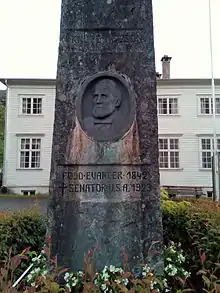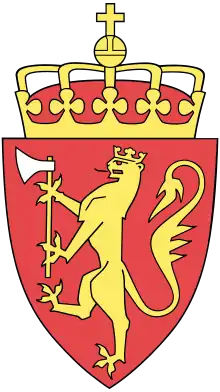Evanger
Evanger is a former municipality in the Voss district of the old Hordaland county in Norway. The municipality existed from 1885 until 1964 when it was dissolved and its lands split between two municipalities. The 590-square-kilometre (230 sq mi) municipality included the eastern part of the Eksingedalen valley, the area surrounding the lake Evangervatnet, and the Bergsdalen valley.[2]

Evanger herad | |
|---|---|
 Hordaland within Norway | |
 Evanger within Hordaland | |
| Coordinates: 60°39′N 06°07′E | |
| Country | Norway |
| County | Hordaland |
| District | Voss |
| Established | 1 Jan 1885 |
| Disestablished | 1 Jan 1964 |
| Administrative centre | Evanger |
| Government | |
| • Mayor (1948-1963) | Ivar Bjørgo (Sp) |
| Area | |
| • Total | 590 km2 (230 sq mi) |
| *Area at municipal dissolution. | |
| Population (1963) | |
| • Total | 1,326 |
| • Density | 2.2/km2 (5.8/sq mi) |
| Demonym(s) | Vassvøring[1] |
| Time zone | UTC+01:00 (CET) |
| • Summer (DST) | UTC+02:00 (CEST) |
| ISO 3166 code | NO-1237 |
| Preceded by | Voss in 1885 |
| Succeeded by | Voss and Vaksdal in 1964 |
The administrative centre of the municipality was the village of Evanger where Evanger Church is located. Evanger Church served the central part of the municipality. Nesheim Church and Eksingedal Church served the northern part of Evanger and Bergsdalen Church served the southern part of the municipality.
History
The municipality was established on 1 January 1885 when the western district of the large municipality of Voss (population: 2,045) was separated from Voss to become the new municipality of Evanger. During the 1960s, there were many municipal mergers across Norway due to the work of the Schei Committee. On 1 January 1964, the municipality of Evanger was dissolved. The Bergsdalen and Eksingedalen valleys (population: 251) were merged with parts of the municipalities of Bruvik and Modalen to create the new Vaksdal Municipality. The rest of Evanger, with 1,075 inhabitants, was merged into the neighboring Voss Municipality.[3]
Municipal council
The municipal council (Heradsstyre) of Evanger was made up of 17 representatives that were elected to four year terms. The party breakdown of the final municipal council was as follows:
| Party Name (in Nynorsk) | Number of representatives | |
|---|---|---|
| Labour Party (Arbeidarpartiet) | 4 | |
| Conservative Party (Høgre) | 1 | |
| Centre Party (Senterpartiet) | 7 | |
| Liberal Party (Venstre) | 5 | |
| Total number of members: | 17 | |
| Party Name (in Nynorsk) | Number of representatives | |
|---|---|---|
| Labour Party (Arbeidarpartiet) | 4 | |
| Conservative Party (Høgre) | 1 | |
| Farmers' Party (Bondepartiet) | 8 | |
| Liberal Party (Venstre) | 4 | |
| Total number of members: | 17 | |
| Party Name (in Nynorsk) | Number of representatives | |
|---|---|---|
| Labour Party (Arbeidarpartiet) | 4 | |
| Farmers' Party (Bondepartiet) | 6 | |
| Joint List(s) of Non-Socialist Parties (Borgarlege Felleslister) | 6 | |
| Total number of members: | 16 | |
| Party Name (in Nynorsk) | Number of representatives | |
|---|---|---|
| Labour Party (Arbeidarpartiet) | 4 | |
| Christian Democratic Party (Kristeleg Folkeparti) | 3 | |
| Farmers' Party (Bondepartiet) | 6 | |
| Liberal Party (Venstre) | 3 | |
| Total number of members: | 16 | |
| Party Name (in Nynorsk) | Number of representatives | |
|---|---|---|
| Labour Party (Arbeidarpartiet) | 4 | |
| Farmers' Party (Bondepartiet) | 6 | |
| Liberal Party (Venstre) | 6 | |
| Total number of members: | 16 | |
| Party Name (in Nynorsk) | Number of representatives | |
|---|---|---|
| Labour Party (Arbeidarpartiet) | 4 | |
| Local List(s) (Lokale lister) | 12 | |
| Total number of members: | 16 | |
Notable residents

- Knute Nelson (1843–1923), United States Senator
- Bjørn Rongen (1906–1983), novelist and children's book writer
- Viking Mestad, politician for the Norwegian Liberal Party
References
- "Navn på steder og personer: Innbyggjarnamn" (in Norwegian). Språkrådet.
- Store norske leksikon. "Evanger – tidl. kommune" (in Norwegian). Retrieved 2014-05-10.
- Jukvam, Dag (1999). "Historisk oversikt over endringer i kommune- og fylkesinndelingen" (PDF) (in Norwegian). Statistisk sentralbyrå.
- "Kommunevalgene og Ordførervalgene 1959" (PDF) (in Norwegian). Oslo: Statistisk sentralbyrå. 1960. Retrieved 2020-02-15.
- "Kommunevalgene og Ordførervalgene 1955" (PDF) (in Norwegian). Oslo: Statistisk sentralbyrå. 1957. Retrieved 2020-02-16.
- "Kommunevalgene og Ordførervalgene 1951" (PDF) (in Norwegian). Oslo: Statistisk sentralbyrå. 1952. Retrieved 2020-02-16.
- "Kommunevalgene og Ordførervalgene 1947" (PDF) (in Norwegian). Oslo: Statistisk sentralbyrå. 1948. Retrieved 2020-02-16.
- "Kommunevalgene og Ordførervalgene 1945" (PDF) (in Norwegian). Oslo: Statistisk sentralbyrå. 1947. Retrieved 2020-02-16.
- "Kommunevalgene og Ordførervalgene 1937" (PDF) (in Norwegian). Oslo: Statistisk sentralbyrå. 1938. Retrieved 2020-05-16.


